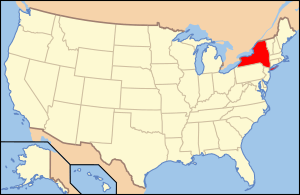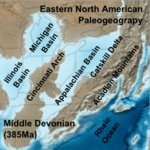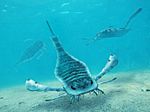Paleontology in New York facts for kids

Paleontology in New York is all about finding and studying ancient life (fossils!) in the state of New York. New York has tons of amazing fossils, especially from a time called the Devonian Period. But there are some missing pieces in the fossil story, especially from the Mesozoic (dinosaur age) and early Cenozoic eras.
Long, long ago, during the early Paleozoic era, much of New York was covered by a warm, shallow sea. This sea was home to many creatures without backbones, like brachiopods (shellfish), conodonts (eel-like animals), eurypterids (sea scorpions), jellyfish, and trilobites (ancient arthropods). Fish with backbones also lived there, including arthrodires (armored fish), chimaeroids (ghost sharks), lobe-finned fishes, and lungfish. By the Devonian Period, New York was even home to some of the oldest known forests on Earth!
We don't have many fossils from the Carboniferous and Permian periods in New York. Not much is known about Mesozoic New York either, but during the early part of this era, meat-eating dinosaurs left their footprints behind, which later turned into fossils. The early to mid-Cenozoic is also mostly missing from the rock record. However, we know that during the Ice Age, huge glaciers covered the state. After the ice melted, creatures like giant beavers and mammoths lived here.
The Silurian sea scorpion Eurypterus remipes is the official New York state fossil.
Contents
Ancient Life in New York

New York has a very rich fossil record. We have very little evidence of life from New York's Precambrian time, but some fossils were found in the Adirondack Mountains. New York was covered by a shallow sea during the Late Cambrian period. Jellyfish lived in the state at this time. Other sea creatures included brachiopods, clams, and trilobites. These groups continued to live in this sea into the Ordovician period.
During the Ordovician, land began to spread westward into the sea from mountains rising in the east. By the Silurian period, sea levels had dropped. As the sea became shallower, especially in the western part of the state, the water became saltier.
Devonian Period Life
Rocks from the Devonian Period show the most fossils in New York. Common sea creatures from this time included brachiopods, different types of corals (like Rugose and Tabulate corals), crinoids (sea lilies), bryozoans (moss animals), squid-like animals (cephalopods), and trilobites. Other life included clams (bivalves), eurypterids, snails (gastropods), hyoliths, phyllocarids, blastoids, cystoids, and sponges. Tiny conodonts and graptolites were also present.
The fish of Devonian New York included small arthrodires (armored fish), chimaeroids (ghost sharks), crossopterygians (lobe-finned fish), lungfishes, and ostracoderms (jawless fish).
Central and southern New York had a river system flowing west during the Devonian. This river formed a large delta called the Catskill Delta. This delta was home to some of the world's oldest known forests, like the Gilboa Forest. It had plants such as seed ferns (Eospermatopteris), two kinds of lycopods (like modern ground pines and club mosses), creeping vines, ferns, and relatives of modern horsetails. The Carboniferous and Permian periods are missing from New York's rock record because sediments were being worn away instead of being laid down.
Mesozoic Era Life
Most rocks from the Mesozoic Era are missing in New York. However, we know that during the Triassic period, the land began to pull apart, forming deep valleys called rift basins. Dinosaur footprints from a type called Grallator were left behind in what is now Nyack Beach State Park in Rockland County. Other kinds of reptiles also left their footprints. During the Jurassic period, the land continued to split as the supercontinent Pangaea broke apart.
Cenozoic Era Life
Like the Mesozoic, rocks from the early Cenozoic Era are mostly missing in New York. But during the Quaternary period, huge glaciers carved out the state's landscape and left behind lots of sediment. Animals from the Pleistocene (Ice Age) in New York included giant beavers, Short-faced bears, giant bison, caribou, deer, Stag-moose, foxes, horses, mammoths, peccaries, American mastodon, and California tapirs.
Fossil Discoveries and Research
Scientific Research
In the early 1800s, important things happened in New York paleontology. In 1817, the New York Lyceum of Natural History (which later became the New York Academy of Sciences) was started by Samuel L. Mitchill. In 1823, they began publishing their scientific findings in the Annals of the Lyceum.
Later, in the 1840s, an amazing mastodon fossil was found near Newburgh. This mastodon, known as the Warren Mastodon, was so well preserved that scientists could even study what it ate! This helped them understand the ancient forests it lived in. The American Museum of Natural History now cares for this special fossil.
The year 1869 was very important. The American Museum of Natural History was officially created. Also in 1869, digging began at Gilboa Forest. This was an incredible discovery of Devonian plants, thought to be one of the first forests ever! They found seed ferns (Eospermatopteris), two types of lycopods (like modern ground pines), creeping vines, ferns, and relatives of modern horsetails. The museum's magazine, Natural History, started being published in 1897.
Digging at the Gilboa petrified forest continued into the early 1900s, finishing by 1921. Before 1933, not many fossils were known in New York. Early finds included Cambrian jellyfish and eurypterids. Only 15 mammoth fossils had been found before 1933. However, mastodon remains were quite common, with over a hundred found by 1933. More recently, in 1984, the Silurian sea scorpion Eurypterus remipes was named the New York state fossil.
Today, paleontological research continues in New York. The Research Department of the New York State Museum has 17,000 studied fossils and 600,000 more for future research! Geologists are making new discoveries by dating ancient rocks using tiny crystals called zircons. This helps them learn about rocks that are over 2 billion years old. The NYS Museum has departments for invertebrate (animals without backbones) fossils, paleobotany (ancient plants), and Ice Age vertebrate (animals with backbones) fossils. Much current study focuses on understanding ancient climates.
Dr. Lisa Amati became the New York State Paleontologist in 2015.
People Who Studied Fossils
Born in New York
- Truman H. Aldrich was born in Palmyra on October 17, 1848.
- John Alroy was born in 1966.
- Charles Emerson Beecher was born in Dunkirk on October 9, 1856.
- Stephen Jay Gould was born in Bayside on September 10, 1941.
- Ulysses S. Grant IV was born in Salem Center on May 23, 1893.
- William King Gregory was born in Greenwich Village on May 19, 1876.
- Othniel Charles Marsh was born in Lockport on October 29, 1831.
- Karl J. Niklas was born in Manhattan, New York in 1948.
- John Ostrom was born in New York City on February 18, 1928.
- Alfred Romer was born in White Plains on December 28, 1894.
- Charles Doolittle Walcott was born in New York Mills on March 31, 1850.
Died in New York
- J. C. McConnell died in Liberty on July 25, 1904.
- William King Gregory died in Woodstock on December 29, 1970 at age 94.
- Stephen Jay Gould died in Manhattan on May 20, 2002 at age 60.
Cool Places to Find Fossils
- Hiscock Site, Byron
- Hyde Park Mastodon, Hudson River Valley
- Miscellaneous Devonian Sites, Statewide
- Penn Dixie Fossil Park & Nature Reserve, Hamburg
Natural History Museums
- American Museum of Natural History, New York City
- Buffalo Museum of Science, Buffalo
- Dinosaur Walk Museum, Riverhead
- Museum of Long Island Natural Sciences, Stony Brook University, Stony Brook
- Natural History Museum of the Adirondacks, The WILD Center, Tupper Lake
- New York State Museum, Albany
- Niagara Science Museum, Niagara Falls
- Paleontological Research Institution and Museum of the Earth, Ithaca
- Pember Museum of Natural History, Granville
- Vanderbilt Museum, Centerport
Clubs and Groups for Fossil Fans
- The New York Paleontological Society
- Buffalo Geological Society, Inc.


